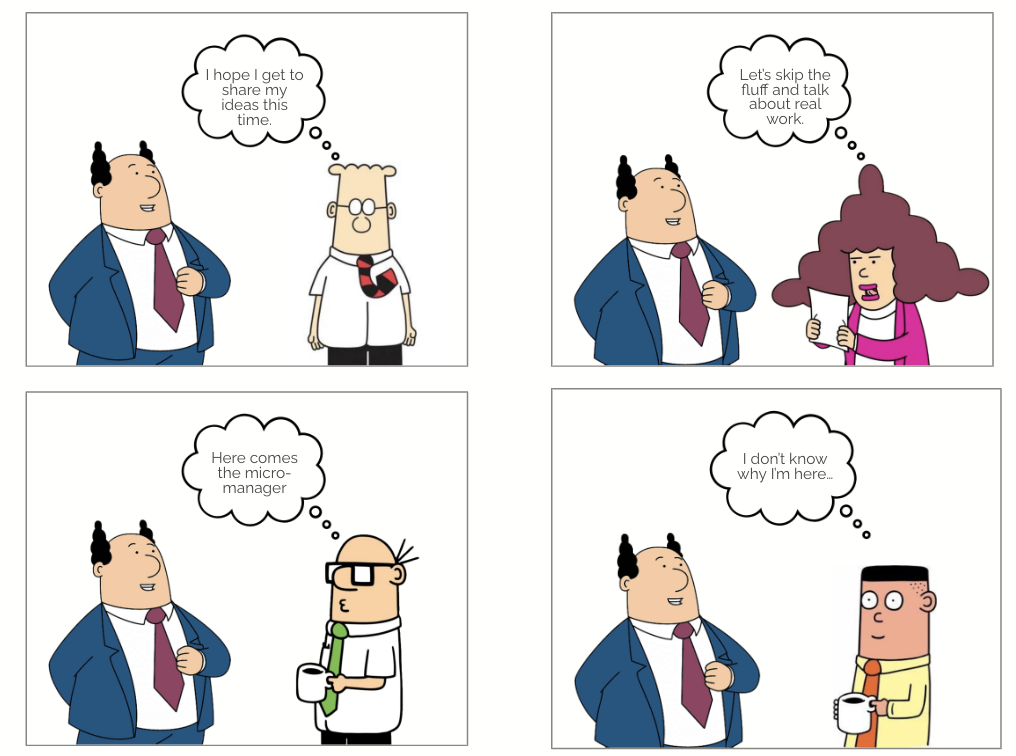
Boost Leadership Effectiveness with One-on-Ones
Let’s face it, engaged employees are productive employees. Studies show that when employees feel seen, heard, and supported, they’re more likely to bring their best selves to work. That’s where one-on-one meetings come in. These regular check-ins aren’t just a box to tick; they’re a powerful tool for boosting leadership effectiveness and employee engagement.
Why One-on-Ones Matter
Regular one-on-one meetings are crucial for building trust and fostering communication with your team. One meaningful conversation per week develops high-performance relationships more than any other single leadership activity. In fact, when employees have quarterly progress checks, they are 90% more likely to be engaged.
So, what’s the goal? One-on-one meetings are your chance to take a pulse on these top engagement drivers:
- My boss understands me.
- What I do helps impact the rest of the team.
- I have clarity and tools to get the job done.
We get it. The fact of the matter is, while the concept of a one-on-one is simple, the practice of finding time, having the right conversation, and mustering up the motivation is not always easy. It’s a big reason why 41% of one-on-one meetings get rescheduled every week. What if you had a simple system for making one-on-ones actually productive?
The ABCs of Successful One-on-Ones
Conducting impactful one-on-ones are simple as A, B, C. Seriously, this is not a huge time investment–you can have a meaningful conversation in as little as 10 minutes.
A: Ask Powerful Questions
One-on-one’s are not your chance to shower your direct reports in a potpourri of advice. Instead, focus on asking thought-provoking questions that encourage your employee to share their thoughts, challenges, and goals. Ask what support they need, how you can be a helpful leader, and what will drive them to success. This 80/20 rule (80% employee talking, 20% leader) ensures you’re getting valuable feedback and actually guiding your employee. What you want is for your employee to be talking while you ask good, thoughtful questions–that’s coaching.
B: Build Credit in the “Trust” Bank
“Do I trust my boss” is a key indicator you can count on to help you know that your employees like their job. During these meetings, purposely take time to listen to your employee’s concerns, celebrate their wins, and demonstrate your commitment to their development. When you think of your top performers, you’ll realize that you already have a trust bridge built with them. What about your other employees that you don’t have a fantastically amazing relationship with (yet)? I’ll point you back up to “A” – asking questions.
C: Coaching for Motivation
Think of your one-on-ones as micro-coaching sessions. Whether you coach by flyby or have something scheduled, tailor your approach to each employee’s personality and communication style. How do you do that? If you’re an overachiever, read on to learn about motivational frameworks.
Motivational Framework: Different Strokes for Different Folks
Here’s the kicker: there’s no one-size-fits-all approach to coaching. If you approach every one-on-one with the same conversations, same goals, and same energy–you’re still going to get different results. Employee #1 is thinking “Totally, got it, chief, I’m excited”. Employee #2 seems quiet and isn’t exactly sure what the takeaway is. Employee #3 is wishing in the back of their brain “please land the plane”. Meanwhile, Employee #4 is wondering if they’re getting promoted or fired.
Why? Each of your employees has an array of motivations. Your coaching style might not resonate with everyone.

By understanding the different motivational framework and communication styles of your people, you can tune into the right channel and get your message heard. This will create a more engaged and productive one-on-one.
Extraversion: Quiet Thinker or Chatty Cathy?
Understanding your employees’ communication preferences can make a world of difference. Some team members are naturally chatty (extroverted), while others prefer a more reserved approach (introverted). Visualize a top performer and take an educated guess on which style they are (extraverted or not).
The picture of Low Extraversion (Introversion):
- Known for being analytical
- Dislikes small talk
- Rolls their eyes at office drama/politics
- Does their best work solo
- Thrives when given space/time to think
When working with Introverts:
- Do skip the fluff and get to the point–they don’t need small talk to feel connected.
- Do give them time to think; they don’t like being put on the spot.
- Don’t barge in, unexpected; they value their privacy.
- Don’t talk over them–they have a symphony of puzzle-solving going on in their head and are more productive without you yapping.
The picture of High Extraversion:
- Known for being enthusiastic
- Likes being noticed, dislikes being ignored
- Desires to be included and include others
- Does their best work in a group
- Thrives when building relationships
When working with High Extraverts:
- Do let them think out loud–they’re more productive when they’re talking to you. Extraverts want to see your face, talk to you about things, and communicate more frequently.
- Do praise their work (they like recognition!)
- Don’t cancel one-on-one’s–this takes a toll on the extravert; they’ll internalize the idea that their time is not important.
- Don’t shut down their ideas–if you don’t respect their input, they’ll start to shut down.
If you simply pick one “do” or one “don’t” and apply it to your next one-on-one, you’re on your way to creating greater impact and more productivity.
Formality: Structured Perfectionist or Big Picture Dreamer?
Similarly, some employees prefer detailed instructions and clear expectations (high formality), while others are comfortable with a more big-picture approach (low formality). Same exercise, here–can you visualize if your employee has low or high formality?
The picture of Low Formality (Informal):
- Known for being more casual
- Finds ways to work around the rules
- Comfortable going with the flow
- Big on starting, not on following through
- Thrives being a “big picture” thinker
When working with Low Formality:
- Do give them autonomy, they need to feel like they have control over their work.
- Do describe the big picture, that’s how their brain looks at things.
- Don’t box them in–they are more productive when you skip the details and simply point them in the right direction.
- Don’t avoid accountability–provide the hard guardrails and checkpoints before you set them loose.
The picture of High Formality:
- Known for attention to detail
- Desires perfection and loathes mistakes
- Likes to be structured, so they can know how to get things right
- Produces detailed, quality work
- Thrives under clear expectations
When working with High Formality:
- Do give clear expectations; they want to know what the rubric is to get an A+.
- Do ask what else they need–they will have questions, so be available.
- Don’t say “don’t worry about it”. Now you’ve created cause for them to be worried.
- Don’t criticize their work–they are their own harshest critic. Instead, help them recover from mistakes and move forward.
The key takeaway? Be adaptable! Recognize your team members’ preferences and lean into their strengths so you can let their freak flag fly.
Your Self-Scoring Checklist
To make your one-on-one meetings genuinely impactful and drive talent optimization, focus on answering these questions:
- Does my employee feel like “my boss gets me”?
- Do I know my employee’s motivational framework towards extraversion (high or low) and formality (high or low)?
- Have I picked one area I can adapt (do or don’t) to communicate more effectively?
- Did I listen more and ask questions (80/20 rule)?
Conclusion
Everyone knows an engaged employee is a more productive employee. A successful one-on-one meeting directly impacts employee engagement and, good news, you now have the keys to success. By mastering the ABCs, embracing a motivational framework, and adapting your communication style, you can turn one-on-ones into powerful coaching conversations that accelerate performance faster than an over-caffeinated chipmunk.
Leadership is hard. We make it easy.
Use the Coaching Conversation Prep Form to take one-on-one’s from snooze-fest to success.


